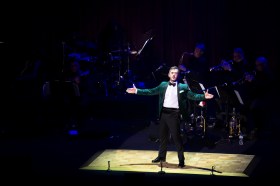Image by Sergio Delle Vedove via Shutterstock
Music is known to provoke the senses, give pleasure and sometimes move people to tears. Surely this has little to do with mathematical models which are so frequently associated with cold and rational logic. So what can maths tell us about this powerful phenomenon closely connected to the emotions? Can mathematics help us measure what’s sublime or ineffable about a piece of music?
Music evokes strong emotions such as frisson (goose bumps), awe and laughter – and has been found to use the same reward pathways as food, drugs and sex to induce pleasure. A shiver down one’s spine or an uncontrollable guffaw when listening to music is most often a case of the music defying your expectations. Expectations can be defined in two ways: schematic – knowing how a genre of music is supposed to go – or veridical – knowing how a particular piece of music unfolds.
On one end of the spectrum, a performance or a piece of music that does just what you’d expect runs the risk of becoming banal. On the other end, music like that of PDQ Bach – which uses tongue-in-cheek egregious violations of known expectations – makes many people laugh.
PDQ Bach: The Short-tempered Clavier: Minuet in C. EC, Author provided735 KB (download)
The craving that comes from musical anticipation and the euphoria that follows the reward have both been found to be linked to dopamine release. As a result, performers and composers alike play with listeners’ expectations, often going to great lengths to carefully choreograph their expectations, and then sometimes breaking them, to provoke and heighten emotional responses.
Playing with expectations
In tonal music, which is almost all of the music that we hear and can be thought of as being based on a scale, the note sequence sets up expectations, then suspends, fulfils, or violates them. For a simple example, sing the first three phrases of “Happy Birthday” and stop at the end of the penultimate phrase.
Happy Birthday (first part) EC, Author provided284 KB (download)
Anticipation for the resolution to this musical cliffhanger creates a palpable knot in the gut. This hollow feeling can be further intensified by delaying the final phrase. The release is evident when the final phrase is heard and ends happily on the most stable tone.
Happy Birthday (second part) EC, Author provided156 KB (download)
Two things are at work here in this miniature example: tonality and time. Tonality provides a framework through which expectations are formed – and the play on time, the delaying of expectations, uses the framework to create a musical cliffhanger and titillate the senses.
Where maths comes in
Expectations can be modelled mathematically and time can be measured – so the shaping of both expectations and time can be described in numbers. Over the years, in my research lab, we have developed models and computer algorithms for quantifying tonal properties and expressive parameters in music. Many of the tonal analysis algorithms are based on what is known as a “spiral array model”.
The spiral array can be plotted in 3D to allow us to visualise the dynamic evolution of musical keys and spot when the notes and their timing combine to do something interesting to tug at our emotions.
An introduction to the MuSA.RT application which implements the spiral array model and its real-time algorithms for determining chords and keys.
As music is heard, the notes can be mapped to the model, duly weighted and summarised as points inside it. Movements in the space inside the model allow listeners to see deviations from expected tonal behaviour.
PDQ Bach: The Short-tempered Clavier: Minuet in C with real-time spiral array tonal analysis; note the deviant trajectories when the music strays away from the expected tonal context.
Musical tension
Just as pitches that sound close one to another are spatially near each other; the converse is true: pitches that sound far from one another are spatially far apart. Feelings of tension translate to quantifiably big distances – notes mapping to widely dispersed points or pulling far away from an established centre of gravity.
Composers actively vary the tension over time to generate interest and captivate the listener’s attention. The shaping of tension over time also helps create meaningful long-term structure. It is notoriously hard for computer algorithms to generate music with long-term structure. But the MorpheuS system, developed by music researcher Dorien Herremans, circumvents this problem to generate music with a pre-set narrative structure by using a tension model based on the spiral array. Listen to this version of JS Bach’s “Minuet in D”:
MorpheuS-Bach: A Little Notebook for Anna Magdalena: Minuet in D. EC, Author provided582 KB (download)
It follows the tension profile, rhythms, and repetition patterns of the original piece from A Little Notebook for Anna Magdalena Bach:
JS Bach: A Little Notebook for Anna Magdalena Bach: Minuet in D. EC, Author provided605 KB (download)
The notes of the generated piece also conjures up similar degrees of tension to the original music. For example, discordant sounds follows the same patterns of discord in Bach’s original piece.
Tipping points
Not only do notes themselves create tension, a performer can delay resolutions to heighten suspense. Judicious use of timing is one of the most potent expressive devices for eliciting emotional responses. The right amount of delay can sweeten the anticipation – but take too much time and the performer risks losing the listener.
In music with a beat, the musical pulse forms a baseline grid on which to measure timing deviations – prolongations and reductions of the time unit. In extreme cases, these warpings of musical time produce tipping points, the feeling of being poised at the brink of an abstract hill in an imaginary roller coaster.
Tipping points in Fritz Kreisler’s recording of his Schön Rosmarin.

Beat lengths in Fritz Kreisler’s Schön Rosmarin as performed by Kreisler: example of tipping points. Elaine Chew
We can use maths to present this graphically. When a piece of music is performed precisely as written, it is displayed as a flat line in these graphs. But music is almost never played exactly as written. Performers often exercise significant creative license; as a result, anomalous peaks signal the evocation of musical tipping points.
Tipping points in Maria Callas’s recording of O Mio Babbino Caro from Giacomo Puccini’s opera Gianni Schicchi.

Beat lengths in Giacomo Puccini’s O Mio Babbino Caro as performed by Kathleen Battle, Maria Callas and Kiri te Kanawa: example of tipping points. Elaine Chew
By elongating specific notes – or words or syllables – the performer draws the listener’s ears to details that might have been missed or glossed over. Because the listener often knows what’s coming, the delay prolongs expectation – creating drama and exaggerating emotional cues.
![]() Mathematics is the language through which scientists understand the nature of the universe. However, the extent to which numbers can explain the ephemeral experience of music has yet to be fully explored. Why does music move us? How do its variegated structures translate to musical expectations? How do performers and composers exploit these expectations to craft profound and moving musical experiences? Our mathematical forays into these questions are but the tip of the ice berg.
Mathematics is the language through which scientists understand the nature of the universe. However, the extent to which numbers can explain the ephemeral experience of music has yet to be fully explored. Why does music move us? How do its variegated structures translate to musical expectations? How do performers and composers exploit these expectations to craft profound and moving musical experiences? Our mathematical forays into these questions are but the tip of the ice berg.
Elaine Chew, Professor of Digital Media, Queen Mary University of London
This article was originally published on The Conversation. Read the original article.





